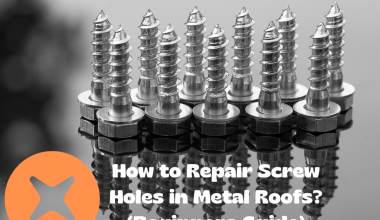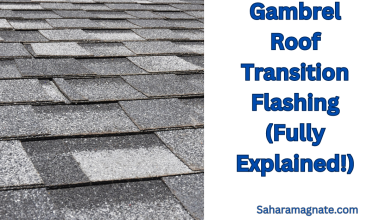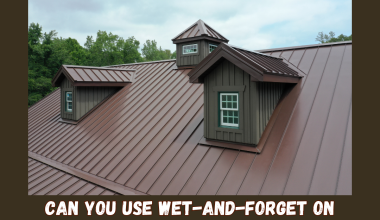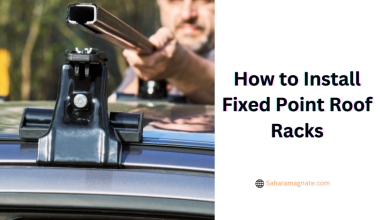Have you recently installed concrete roof tiles in your home or business? Then you know just how essential proper maintenance is to ensure these tiles stay in their best condition.
Unfortunately, concrete roof tiles can still have problems even with regular maintenance.
From erosion and mildew to broken pieces and displaced sections, there’s no way around that it’s essential to be aware of the common problems that can thwart your roof’s look, function, and lifespan.
To help you, we’ve created a list of the 15 most common concrete roof tiles problems and solutions so you can spot issues before they become serious—and take action quickly if necessary.
Ready to learn how to identify, prevent, and solve some of the most common issues of maintaining a concrete tiles roof? Let’s get into it!
15 Common Concrete Roof Tiles Problems And Solutions
Concrete roof tiles are an increasingly popular choice for safeguarding your home. However, like any material, they are not immune to issues.
So it’s essential to know common concrete roof tiles problems and solutions.
Here are the top 15 issues you should look out for:
- Corrosion of Concrete Roof Tiles
Corrosion of roof tiles is a common problem in concrete roofing. This form of corrosion occurs when the tiles are exposed to moisture and air, and consequently, the metal parts of the tiles start to wear down.
Unfortunately, corrosion can be hard to spot until it’s too late. You might not realize your concrete roof tile has corroded until you see noticeable damage, such as flaking paint or cracked edges.
And since corrosion usually happens gradually over time, it can be challenging to pinpoint the root cause immediately.
Proper maintenance and regular inspections are the best remedies to prevent corrosion on your roof tiles.
Look for signs of water damage regularly, and immediately repair any cracked or broken tiles.
Additionally, make sure that your gutters are clear of debris and that there is proper drainage in place around the perimeter of your home.
These simple solutions can inhibit oxidation and keep your roof looking great for years!
- Unsealed or Poorly Sealed Concrete Roof Tiles
One of the most common problems industry experts encounter is unsealed or poorly sealed tiles.
If your tiles are unsealed or not properly sealed, they can be easily damaged by moisture, UV rays, and other elements.
Additionally, you may find that your roof isn’t correctly ventilated if you have an unsealed tile roof.
That said, there are a few solutions that can help you address this issue:
- Have your roof professionally inspected for damage. If the specialist finds any imperfections or damage, they can recommend a solution for sealing and reinforcing the roof tiles to prevent further damage.
- Apply a sealer to the entire roof to protect it from moisture and UV rays.
- Use professional-grade products to apply the sealer evenly and correctly to get optimal protection from rain and other elements.
- Ensure your roof has proper ventilation; an experienced contractor can help identify any issues that need to be addressed to maintain the longevity of your concrete roof tiles and keep them looking their best for years to come!
3. Broken or Damaged Tiles
You may have noticed that one or more of your concrete roof tiles are cracked, chipped, or damaged.
If this happens, the only solution is to replace the broken tile with a new one. However, it’s essential to take the time to identify and address the underlying cause of the damage before replacing any tiles.
Causes of Damage
Typically, damage to concrete roof tiles is caused by one of two things:
- Incorrect installation and
- Poor-quality materials. The former could be due to improper measurements when installing the tiles, while the latter can be down to a substandard material.
Solutions for Broken Tiles
To prevent more damage from occurring, it’s essential to address the root cause before fixing any broken or damaged tiles.
If you determine an installation error, you should ensure that all future installations are done correctly and according to specs.
And if you discover that cheap materials were used during construction, it’s time to invest in high-quality building materials and supplies.
Once these underlying issues have been fixed, then all that’s left is to replace any damaged tiles that were previously installed.
Ensure you buy high-quality replacements from a reputable manufacturer to ensure long-term durability and satisfaction with your roofing system.
4. Improper Installation of Concrete Roof Tiles
You might not be aware, but the improper installation of concrete roof tiles is one of the top 15 problems with concrete roof tiles.
You must ensure your installer knows what they’re doing because a bad job can lead to severe problems.
Here are the most common problems caused by improper installation of concrete roof tiles:
- Warping – if the tiles are installed too tightly, there isn’t enough room for air circulation which will cause them to warp.
- Cracks – If the tiles are installed incorrectly, any movement caused by wind or other environmental factors can cause cracks to appear in the tiles.
- Leaks – Improperly installed tiles can create gaps between and around them, leading to water leakage and damaging your home and possessions.
Fortunately, these issues can be avoided by hiring an experienced professional familiar with proper installation techniques for concrete roof tiles. It may cost a bit more upfront, but it will save you headaches (and money) in the long run!
5. Algae, Moss, and Lichen Growth on Concrete Roof Tiles
Algae, moss, and lichen can all grow on concrete roof tiles, especially on surfaces with poor insulation.
This is terrible news for any homeowner, as this growth can make your roof look unattractive. It can also reduce the roof’s ability to keep the elements out.
Luckily, you don’t have to tear up your roof tiles to eliminate the problem. For example, several chemical treatments can kill and prevent algae, moss, and lichens from growing.
You can also use a pressure washer or a garden hose with a spray attachment to remove them manually.
On top of this, proper insulation and ventilation help prevent the recurrence of these pesky growths on concrete roofing tiles.
If you have good insulation and ventilation, you won’t need to worry about algae or moss growth, as they need moisture and warmth to survive.
6. Dark Patches on Tiles Due to Moisture Retention
Moisture retention is one of the common concrete roof tiles problems. If moisture gets trapped between your tiles, you may see dark patches.
These dark patches are caused by the growth of algae and fungi, which thrive in damp conditions. This can be a real problem if you live in an area with long periods of humid weather.
The good news is that tackling this problem doesn’t have to be complicated. Here are some simple solutions:
- Make sure your roof is adequately ventilated and has adequate insulation.
- Clean the tiles with a degreaser to remove any built-up oil or grease, which can also contribute to moisture retention.
- Seal your tiles with an acrylic-based sealant designed for concrete roof tiles, which will help protect them from further moisture damage going forward.
- Keep your gutters clean and free from debris—this will help prevent water from pooling on the roof and forming pools where fungi can grow and thrive.
- Consider installing a waterproof underlayment beneath the tiles, which will also help keep them dry and mold-free for extended periods.
Taking these steps can make all the difference in keeping those dark patches away and ensuring that your roof looks its best for years to come!
7. Noticeable Cracks and Discolorations in the Tiles
It’s not unusual to see noticeable cracks and discolorations in your concrete roof tiles. These occur over time due to natural deterioration, weather conditions, and other factors such as vibrations from wind or traffic.
Fortunately, there are ways you can fix this problem. A few of them include the following:
- Regular inspection of your roof tiles for signs of wear and tear. If you notice any cracks or discolorations, replace the affected tile ASAP.
- Re-coating or re-staining the tile with a concrete coating solution or paint. This will help protect the surface of the roof tiles against future damage.
- Adding a sealant to the existing tile to reduce water absorption and keep out dirt and debris. This will also help reduce cracking and discoloration in the long run.
- Replacing damaged tiles with new ones made from concrete or clay materials that are more durable and resistant to weathering over time.
By regularly checking your roof tiles for signs of wear and tear, using protective coatings, adding sealants, and replacing damaged tiles, you can maintain a beautiful roof for years to come!
8. Improper Flashings Around Chimneys and Valleys
Having the correct flashings around your chimney and valleys is extremely important for the upkeep of your roof.
Improperly installed flashings can cause water leaks, which can cause severe damage to your roof and home.
Fortunately, there are a few things you can do to make sure you have the proper flashings installed:
- Ensure proper drainage – Make sure to check that your roof is correctly graded so that water flows away from any chimneys or valleys that may be present in your roof.
- Install metal flashing – Metal flashing will provide protection against any potential water leaks in these areas as it will form a waterproof seal around the chimney or valley.
- Use concrete roof tiles – Concrete roof tiles are a great option to ensure proper waterproofing and protection against any water leaks in these areas, as they are highly durable and long-lasting.
Making sure that your flashings are correctly installed and maintained is key in keeping your roof healthy and ensuring it lasts for years to come.
Taking the time to check that everything is up to code now will save you time and money.
9. Lack of Maintenance of Concrete Roofs
One of the biggest issues is the lack of maintenance. Just like any other material that makes up a roof, regular maintenance and strong weatherproofing will help keep it in peak condition and make it last longer.
The thing with concrete roof tiles is that they need to be inspected regularly. That means checking for cracks, loose tiles or nails, mold or moss growth, etc. Fortunately, the process isn’t particularly strenuous and can be done quickly.
It’s also important to remember that some weatherproofing products should be used on concrete roofs every two to three years to keep them in top shape.
Depending on the type of weatherproofing material used, this may range from simply touching up existing coats with a sealant to completely stripping off the old coat and starting fresh.
Finally, avoid walking directly on concrete roofs whenever possible—it’s a good idea to avoid this even if there are no visible signs of damage or disrepair.
The constant pressure can cause tiles to crack over time, so try using a ladder when inspecting or cleaning concrete roofs.
10. Blocked Gutters and Scuppers
When your gutters and scuppers get blocked with debris, that can be a problem. This can cause damage to the parts of your roof or even lead to leaks.
To prevent this issue, you should regularly clean your gutters and scuppers. Here’s how:
- Start by ensuring you have the right tools, such as ladders, gloves, a broom, and a bucket.
- Make sure everything is secure before you start to work—this includes wearing the right safety equipment and making sure the ladders are properly supported so that they won’t slip.
- Once everything is ready, use the broom to sweep away leaves, sticks, and other debris from the gutters and scuppers so that they’re clear.
- When you’re done, use a hose to flush out any remaining debris from the system—this will ensure that it’s completely clear of blockages before you start using it again.
It’s important to regularly inspect your gutters and scuppers to ensure they’re debris-free.
If any blockages are found, quickly address them to prevent any potential damage or leaks.
11. Decking Deterioration or Weak Structural Support
If the support structure that your concrete roof tile is on starts to weaken, it could lead to decking deterioration.
For example, if timber rafters start to rot or weaken due to dampness or other factors, it could lead to your roof tiles shifting or cracking.
Here are a few things you can do to prevent this from happening:
- Ensure the decking is adequately supported and enough overlap between the tiles.
- Inspect your roof regularly, and look for any signs of movement or cracking in the tiles.
- Be mindful of where you put any ladders or other objects when accessing the roof for maintenance/repair work, as concentrated weight might cause damage over time.
- If anything looks damaged or out of place, don’t hesitate to call a roofing professional immediately—it’ll save you a lot of trouble in the long run!
12. Tree Branch Damage or Wind Uplift
Sometimes, tree branches or wind can damage concrete roof tiles or cause them to be lifted.
To prevent this, always ensure a 6-inch gap between the roof tile and any overhanging tree branches or nearby structures subject to high winds.
You can also consider using stronger roof anchor bolts when installing concrete roof tiles.
These anchor bolts are designed to hold down your roofing tiles in high wind conditions securely.
The best way to ensure these bolts are doing their job is to periodically check them to ensure they haven’t become loose or damaged.
If you find that either tree branches or Wind Uplift has damaged your roof tiles, it may be necessary to replace the tiles.
You must take action quickly; otherwise, the damage could worsen and become more expensive to repair.
13. Poor Quality of Aggregates in the Roof Tiles
One common concrete roof tiles problem is using poor-quality aggregates. Poor quality aggregates can significantly diminish the performance and durability of the roof tiles, leading to cracking, breaking, and water leakage over time.
To avoid this problem, use high-quality aggregates in your concrete roof tiles. Additionally, take the necessary steps to install and maintain the roof tiles properly.
Proper installation includes checking for any irregularities or gaps in the tiles’ layout and ensuring they are properly sealed and secured.
Maintenance should include regular cleaning and inspecting for any signs of damage or wear and tear.
By taking these steps, you can ensure that your concrete roof tiles will remain durable and secure.
14. Poor Quality Adhesive in the Roof Tiles
The last problem you might run into with concrete roof tiles is poor adhesive in the tiles.
If the adhesive isn’t strong enough, then the tiles won’t be able to stick to the roof correctly. This can result in tiles slipping off or coming loose over time, and that’s never a good sign.
Fortunately, there are a few solutions for this problem:
- Make sure you use quality-grade adhesive when installing your concrete roof tiles.
- Add extra layers of adhesive when necessary — it’s better to be safe than sorry.
- Apply additional sealants or clamps on top of the adhesive for added security.
- Increase the number of battens and fixings used to secure tiles to the roof structure if necessary.
- Use a waterproofing sealant on top of your tiles to protect them from extreme weather conditions and temperature changes.
By taking these steps, you can ensure that your concrete roof tiles are placed securely on your roof, with little risk of slipping or coming loose due to poor-quality adhesive in the tiles.
15. Poor Quality Cement
Did you know that poor-quality cement is one of the major problems with concrete roof tiles? It’s true! Poor-quality cement contains lower purity and higher levels of impurities.
This results in a weaker material that can cause cracking, crumbling, and other defects in your tiles.
If you suspect this is an issue, the first thing to do is check out the supplier. Ensure they use high-grade cement with consistent particle size, which will help ensure a stable structure.
Additionally, too much water can cause problems, such as excessive shrinkage in the concrete slabs and lower compressive strength.
To prevent any issues with poor-quality cement, make sure to:
- Choose a reputable supplier with high-grade cement
- Ask for consistent particle size of the cement
- Test for excess water content in your concrete mix
Conclusion
Concrete roof tiles are an excellent choice for homeowners looking for a durable, long-lasting solution.
While some common problems are associated with concrete roof tiles, these can be prevented if proper maintenance protocols are in place.
The key takeaways are to inspect your concrete roof tiles regularly, use the right sealant and seal it regularly and don’t skimp on getting a quality product.
If you diligently maintain your concrete roof tiles and seek expert advice, you can enjoy your roof tiles for many years to come.






